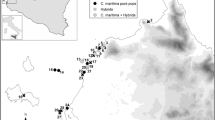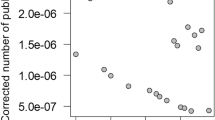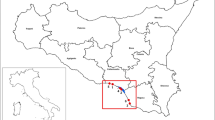Abstract
We compared the Atlantic and Mediterranean beach and foredune habitats of European interest, focusing on floristic, structural and ecological features. We selected two representative sites of Atlantic (The Netherlands) and Mediterranean (Italy) coastal dunes. From a georeferenced vegetation database, samples of: (a) annual vegetation on drift lines (European Union habitat type 1210), (b) embryonic shifting dunes (2110), and (c) shifting dunes along the shoreline with Ammophila arenaria (2120), were selected. Floristic representativity and comparability of plot sizes were considered. For each habitat, the frequency and the fidelity of the species, the life form frequency spectra and Ellenberg ecological indicator values were assessed. We found a consistent floristic differentiation between the Atlantic and the Mediterranean coastal dune habitats and only a small set of shared species. The Italian and the Dutch annual vegetation of drift lines (1210) register a high structural similarity that strongly declines landwards. Floristic composition, life forms and Ellenberg indicator values show higher similarities among different foredune habitats of the same site than between homologous habitats of the Mediterranean and Atlantic coasts. The results confirm the current description and distribution of the habitat of European interest annual vegetation of drift lines (1210). On the other hand, the floristic, structural and ecological differences between the Atlantic and the Mediterranean embryonic shifting dunes (2110) and shifting dunes along the shoreline with Ammophila arenaria (2120) point at an inconsistency of the existing description of those habitats of European interest and highlight the need of adding in the Directive specific types that describe them in the Mediterranean basin. We suggest the introduction of two new habitat types named “Dunes along the Mediterranean shoreline with Ammophila arenaria” (new code 2280) and “Mediterranean embryonic dunes” (new code 2290) within the existing class “Sea dunes of the Mediterranean coast” (class 22 of the Annex I Habitats Directive 92/43/CEE).




Similar content being viewed by others
Abbreviations
- EU:
-
European Union
- DCA:
-
Detrended Correspondence Analysis
References
Acosta A, Blasi C, Stanisci A (2000) Spatial connectivity and boundary patterns in coastal dune vegetation in the Circeo National Park, Central Italy. J Veg Sci 11:149–154
Acosta A, Blasi C, Carranza ML et al (2003) Quantifying ecological mosaic connectivity and hemeroby with a new topoecological index. Phytocoenologia 33(4):623–631
Acosta A, Carranza ML, Izzi CF (2009) Are there habitats that contribute best to plant species diversity in coastal dunes? Biodivers Conserv 18:1087–1098
Bakker TWM, Doing H (1987) De Nederlandse kustduinen en hun internationale betekenis. Duin 10(1–2):34–41
Biondi E (2007) Thoughts on the ecology and syntaxonomy of some vegetation typologies of the Mediterranean coast. Fitosociologia 44(1):3–10
Biondi E, Brugiapaglia E, Allegrezza M et al (1991) La vegetazione del litorale marchigiano (Adriatico centro-settentrionale). Coll Phytosoc 19:429–460
Biondi E, Blasi C, Burrascano et al (2009) Italian interpretation manual of the 92/43/EEC Directive habitats. Ministero dell’Ambiente e della Tutela del Territorio e del Mare. http://vnr.unipg.it/habitat. Accessed 15 July 2010
Blasi C (2003) Bioclimate of Italy. In: Blasi C (ed) Ecological information in Italy. Ministero dell’Ambiente e della Tutela del territorio- Società Botanica Italiana, Rome, pp 11–12
Blasi C, Michetti L (2005) Biodiversità e clima. In: Blasi C, Boitani L, La Posta S et al (eds) Stato della biodiversità in Italia. Contributo alla strategia nazionale per la biodiversità. Palombi Editori, Roma, pp 57–66
Bohn U, Neuhäusl R (2000/2003) Map of the natural vegetation of Europe. Scale 1:2 500 000. Bundesamt für Naturschutz, Münster
Brown AC, McLachlan A (2002) Sandy shore ecosystems and the threats facing them: some predictions for the year 2025. Environ Conserv 29:62–77
Carboni M, Carranza ML, Acosta A (2009) Assessing conservation status on coastal dunes: a multiscale approach. Landsc Urban Plan 91:17–25
Carboni M, Thuiller W, Izzi F, Acosta A (2010) Disentangling the relative effects of environmental versus human factors on the abundance of native and alien plant species in Mediterranean sandy shores. Divers Distrib 16(4):537–546
Carranza ML, Acosta A, Stanisci A et al (2008) Ecosystem classification and EU habitat distribution assessment in sandy coastal environments. Environ Monit Assess 140:99–107
Cori B (1999) Spatial dynamics of Mediterranean coastal regions. J Coast Conserv 5:105–112
Davy AJ, Scott R, Cordazzo CV (2006) Biological flora of the British Isles: Cakile maritima Scop. J Ecol 94:695–711
Delbaere BCW (1998) Facts and figures on European biodiversity: state and trends 1998–1999. European Centre for Nature Conservation, Tilburg
Diekmann M (2003) Species indicator values as an important tool in applied plant ecology—a review. Basic Appl Ecol 4:493–506
Diekmann M, Lawesson JE (1999) Shifts in ecological behaviour of herbaceous forest species along a transect from northern Central to North Europe. Folia Geobot 34:127–141
Doing H (1981) A comparative scheme of dry coastal sand dune habitats, with examples from the eastern United States and some other temperate regions. In: Lieth H, Landolt E, Peet RK (eds) Contributions to knowledge of flora and vegetation in the Carolinas. Veröff. E.T.H, Stiftung Rubel, Zurich, pp 41–72
Doing H (1985) Coastal foredune zonation and succession in various parts of the world. Vegetatio 61:65–75
EEA (1995) Europe’s environment: the Dobríš assessment. EEA, Cophenhagen/Luxemburg
EEA (1999) Coastal and marine zones: environment at the turn of the century, chap 3/14. EEA, Copenhagen
EEA (2008) Mediterranean region. Reference list of habitats types and species present in the region. http://biodiversity.eionet.europa.eu/activities/Natura_2000/pdfs/Ref_med.pdf. Accessed 4 July 2010
Ellenberg H, Weber HE, Düll R et al (1992) Zeigerwerte von Pflanzen in Mitteleuropa. Ed. 3. Scr Geobot 18:1–258
Ertsen ACD, Alkemade JRM, Wassen MJ (1998) Calibrating Ellenberg indicator values for moisture, acidity, nutrient availability and salinity in the Netherlands. Plant Ecol 135:113–124
European Commission (2007) Interpretation manual of European Union Habitats—EUR27. http://ec.europa.eu/environment/nature/legislation/habitatsdirective/docs/2007_07_im.pdf. Accessed 2 June 2010
Farris E, Pisanu S, Secchi Z et al (2007) Gli habitat terrestri costieri e litorali della Sardegna settentrionale: verifica della loro attribuzione sintassonomica ai sensi della Direttiva 43/92/CEE “Habitat”. Fitosociologia 44(1):165–180
Fierro G, D’Alessandro L, Landini B et al (eds) (1999) Atlante delle Spiagge Italiane. CNR-MURST SELCA, Firenze
Haveman R, Janssen JAM (2008) The analysis of long-term changes in plant communities using large databases: the effect of stratified resampling. J Veg Sci 19(3):355–362
Hennekens SM, Schaminée JHJ (2001) TURBOVEG a comprehensive data base management system for vegetation data. J Veg Sci 12:589–591
Heslenfeld P, Jungerius PD, Klijn JA (2004) European coastal dunes: ecological values, threats, opportunities and policy development. In: Martínez ML, Psuty NP (eds) Costal dunes, ecology and conservation. Ecological studies, vol 171. Springer-Verlag, Berlin, pp 335–351
Houston JA, Edmondson SE, Rooney PJ (2001) Coastal dune management: shared experience of European conservation practice. University Press, Liverpool
Jongman RHG, Ter Braak CJV, Van Tongeren OFR (1987) Data analysis in community and landscape ecology. Pudoc, Wageningen
Kadereit JW, Arafeh R, Somogyi G et al (2005) Terrestrial growth and marine dispersal? Comparative phylogeography of five coastal plant species at a European scale. Taxon 54(4):861–876
Louisse CJ, Van der Meulen F (1991) Future coastal defence in The Netherlands: strategies for protection and sustainable development. J Coast Res 7(4):1027–1041
Martínez ML, Maun AM, Psuty NP (2004) The fragility and conservation of the world’s coastal dunes: geomorphological, ecological, and socioeconomic perspectives. In: Martínez ML, Psuty NP (eds) Costal dunes ecology and conservation. Ecological studies, vol 171. Springer-Verlag, Berlin, pp 355–369
Maun MA (1994) Adaptations enhancing survival and establishment of seedlings on coastal dune systems. Plant Ecol 111(1):59–70
Maun AM (2004) Burial of plant as a selective force in sand dunes. In: Martínez ML, Psuty NP (eds) Coastal dunes ecology and conservation. Ecological studies, vol 171. Springer-Verlag, Berlin, pp 119–135
Mücher CA, Bunce RGH, Hennekens SM, Shaminée JHJ (2004) Mapping European habitat to support the design and implementation of a pan-European network: the PEENHAB project. Alterra report 952, Wageningen
Nordstrom K, Psuty N, Carter B (eds) (1990) Coastal dunes: form and process. Wiley, Chichester
O’Shea EM, Kirkpatrick JB (2000) The impact of suburbanization on remnant coastal vegetation in Hobart, Tasmania. Appl Veg Sci 3:243–252
Pignatti S (2002) La vegetazione delle spiagge. In: Ruffo S (ed) Dune e spiagge sabbiose. Ambienti fra terra e mare. Quaderni Habitat, vol 4. Ministero dell’Ambiente e della Tutela del Territorio, Museo Friulano di Storia Naturale, Udine, pp 43–61
Pignatti S (2005) Valori di bioindicazione delle piante vascolari della Flora d’Italia (Bioindicator values of vascular plants of the Flora of Italy). Braun-Blanquetia: recueil de travaux de geobotanique/Review of geobotanical monographs, vol 39. Camerino, p 95
Pirone G (1983) La vegetazione del litorale pescarese Abruzzo. Not Fitosoc 18:37–62
Pirone G (1997) La vegetazione del litorale di Martinsicuro nel contesto dell’ambiente costiero dell’Abruzzo: aspetti e problemi. Le Dune di Martinsicuro, Comune di Martinsicuro (TE)
Pirone G (2005) Aspetti geobotanici del territorio di Roseto degli Abruzzi (Teramo, Italia Centrale) - 1 La vegetazione. Micol e Veget Medit 20(1):67–96
Pirone G, Corbetta F, Frattaroli AR et al (2001) Aspetti della vegetazione costiera dell’Abruzzo. Biogeographia 22:169–191
Salman A (1991) EUDC sand dune inventory, Netherlands. In: Doddy JP (ed) Sand dune inventory of Europe. Preliminary draft report for North West Europe. 3° EUDC conference, Galway
Schaffers AP, Sýkora KV (2000) Reliability of Ellenberg indicator values for moisture nitrogen and soil reaction: a comparison with field measurements. J Veg Sci 11:225–244
Stanisci A, Conti F (1990) Aspetti vegetazionali di un settore costiero molisano-abruzzese. Ann Bot (Roma) XLVIII Studi sul Territorio Suppl 7:85–94
Stanisci A, Acosta A, Ercole S et al (2004) Plant communities on coastal dunes in Lazio (Italy). Ann Bot 4:115–128
STATSOFT (2000) Statistica for Windows. StatSoft Inc., Tulsa
Studer-Ehrensberger K, Studer C, Crawford RMM (1993) Competition at community boundaries: mechanisms of vegetation structure in a dune slack complex. Funct Ecol 7:156–168
Taffetani F, Biondi E (1989) La vegetazione del litorale molisano e pugliese tra le foci dei Fiumi Biferno e Fortore (Adriatico centromeridionale). Coll Phytosoc 28:323–349
Taveira Pinto F (2004) The practice of coastal zone management in Portugal. J Coast Conserv 10:147–158
Ter Braak CJF, Šmilauer P (1997–2002) CANOCO for Windows. Software for canonical community ordination (version 4.5). Ithaca
Tichý L (2002) JUICE, software for vegetation classification. J Veg Sci 13:451–453
Tichý L, Chytrý M (2006) Statistical determination of diagnostic species for site groups of unequal size. J Veg Sci 17:809–818
Tutin TG, Burges NA, Heywood VH et al (1964–1993) Flora Europaea: 5 vol. Cambridge University Press, Cambridge
Vagge I, Biondi E (1999) La vegetazione delle coste sabbiose del Tirreno settentrionale italiano. Fitosociologia 36(2):61–95
Vagge I, Corradi N, Ferrari M et al (2007) Aspetti vegetazionali e morfo-sedimentologici dei campi dunari di Platamona-Marritiza con particolare riguardo all’area di Marina di Sorso (Sardegna settentrionale). Fitosociologia 44(1):33–48
Van der Maarel E (2003) Some remarks on the functions of European coastal ecosystems. Phytocoenologia 33(2):187–202
Van der Maarel E, Van der Maarel-Versluys M (1996) Distribution and conservation status of littoral vascular plant species along the European coasts. J Coast Conserv 2:73–92
Van der Maarel E, Boot R, Van Dorp D et al (1985) Vegetation succession on the dunes near Oostvoorne, the Netherlands: a comparison of the vegetation in 1959 and 1980. Vegetatio 58:137–187
Van der Meulen F, Udo de Haes HA (1996) Nature conservation and integrated coastal zone management in Europe: present and future. Landsc Urban Plan 34:401–410
Van der Meulen F, Bakker TWM, Houston JA (2004) The costs of our coasts examples of dynamic dune management from Western Europe. In: Martínez ML, Psuty NP (eds) Costal dunes ecology and conservation. Ecological studies, vol 171. Springer-Verlag, Berlin, pp 259–277
Van Tongeren O, Gremmen N, Hennekens SM (2008) Assignment of relevés to pre-defined classes by supervised clustering of plant communities using a new composite index. J Veg Sci 19:525–536
Wätzold F, Schwerdtner K (2005) Why be wasteful when preserving a valuable resource? A review article on cost-effectiveness of European biodiversity conservation policy. Conserv Biol 123:327–338
Wiedemann AM, Pickart AJ (2004) Temperate zone coastal dunes. In: Martínez ML, Psuty NP (eds) Costal dunes, ecology and conservation. Ecological studies, vol 171. Springer-Verlag, Berlin, pp 53–65
Zadelhoff FJ (1981) Nederlandse kustduinen - Geobotanie. Dissertation, Centre for Agricultural Publication and Documentation, Wageningen
Author information
Authors and Affiliations
Corresponding author
Additional information
Nomenclature of vascular plant species follows Flora Europaea (Tutin et al. 1964–1993).
Rights and permissions
About this article
Cite this article
Feola, S., Carranza, M.L., Schaminée, J.H.J. et al. EU habitats of interest: an insight into Atlantic and Mediterranean beach and foredunes. Biodivers Conserv 20, 1457–1468 (2011). https://doi.org/10.1007/s10531-011-0037-9
Received:
Accepted:
Published:
Issue Date:
DOI: https://doi.org/10.1007/s10531-011-0037-9




